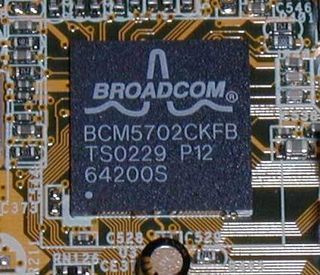Changing Of The Guard: Four Athlon Motherboards For DDR400
The Trend: Gigabit-Ethernet On Board

The network controller with MSI and Asus: Broadcom BCM5702 is supposed to be suitable for Gigabit Ethernet, but works at 10/100 MBit/s as well.
In the past months, integrated network adapters have become increasingly popular.
On the one hand, the corresponding controller chips for 10/ 100 MBit/s have gotten to be quite inexpensive. And on the other hand, the RJ45 port is not only helpful for traditional networks - broadband connections of all types (DSL, cable, powerline) are always connected via RJ45, regardless of whether the computer is directly connected to a modem or if a router (including Ethernet hub or switch) is used.
100 MBit/s is the world standard today. Simple network cards and hubs or switches are inexpensive, and even the cables are affordable as well as multi-purpose (ISDN, for example).
There are differences among network controllers, however: cards such as the 3C905-TX from 3com (our reference model) take on all network tasks, so that the processor does not have to deal with the load most of the time. Because of this, good quality network cards still cost more than $30. The other category of cards only involves the functionality and requires significantly more processor time because many partial functions have to be emulated. These more modest controllers are used on motherboards because they are inexpensive.
Gigabit-Ethernet (1.000 MBit/s) can be implemented in two ways: via the typical copper cable (Cat. 5+ or 6), or via fiber optic cable. The simplest method is certainly to use copper cabling, because, this way, backwards compatibility is guaranteed. This is something not provided by fiber optic cable, and what makes things more difficult is that the components required for this are sometimes extremely expensive.
Even if an integrated Gigabit-Ethernet controller is hardly able to reach the level of a fully-fledged adapter card, the customer can still get the maximum performance and flexibility at a minimally higher price compared to 100 Mbit/s.
Stay on the Cutting Edge
Join the experts who read Tom's Hardware for the inside track on enthusiast PC tech news — and have for over 25 years. We'll send breaking news and in-depth reviews of CPUs, GPUs, AI, maker hardware and more straight to your inbox.
Current page: The Trend: Gigabit-Ethernet On Board
Prev Page Consistent Development: From KT266 To KT333 And KT400 Next Page With DDR400 Into The Future? DDR Memory Based On PC3200 StandardMost Popular

